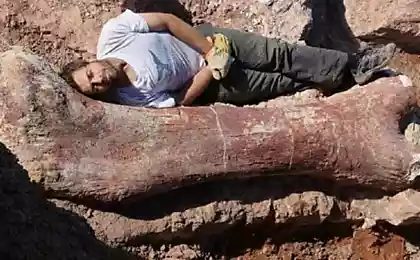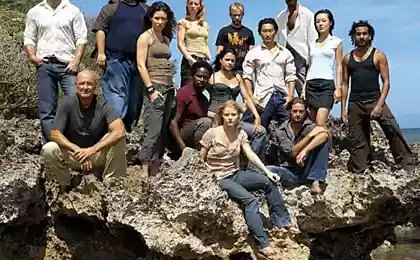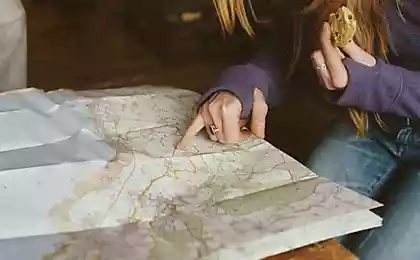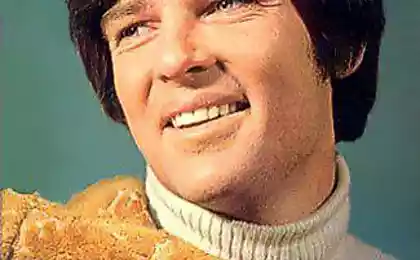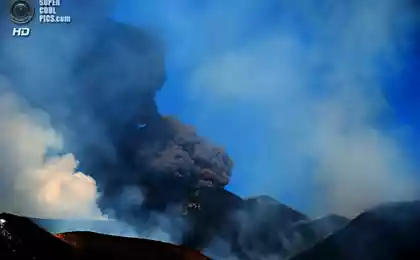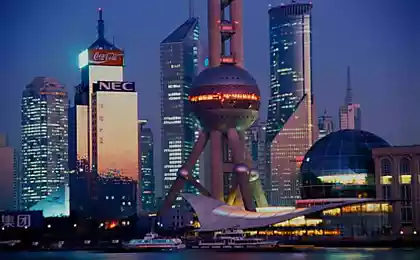451
Time travel— Ostia Antica
Unfortunately, scientists haven't invented a time machine. But us travelers, this is not a hindrance. After all, there are other ways to go back in time. Only 30 minutes drive from Rome and... you're in the ancient city of Ostia Antica, at the beginning of our era.
How to get From Rome to Ostia can be easily reached by train. At the metro station Piramide, not leaving the city, follow the signs to Lido to the train station Porta San Paolo. To buy a ticket for the train doesn't need metro ticket is also valid on the suburban trains in this direction. Trains run every 15 minutes, journey time to the station of Ostia Antica – about half an hour.
History According to legend Ostia was founded by the king of Ankh Marcius in the seventh century BC, but scientists this legend is not confirmed – the most ancient building found on the territory of the city, refers to the IV century BC
Ostia was built in a strategically important location at the mouth of the Tiber, and for nearly seven centuries was the "sea gate" of Ancient Rome. The flourishing period of the city coincided with the heyday of the Roman Empire and then gave way to a period of decline. Political chaos in Rome, a series of earthquakes, an epidemic of malaria – and even before the Middle ages from the former greatness of the city is not gone.
Excavations on the site of Ostia began in the nineteenth century and continue to this day. Today, it is 34 hectares, representing 2/3 of the area of the ancient city.
Unlike the infamous Pompeii and Herculaneum, overnight the death toll from the eruption of Vesuvius, Ostia Antica was dying slowly and gradually, allowing us to see a more complete picture of life during the Roman Empire.
The main street Decumanus Maximus
The city On a full inspection of Ostia you will need at least 3-4 hours, so, starting here, choose comfortable shoes and in summer don't forget to bring a hat and sunscreen.
The first thing you will see in Ostia-Antica, is a necropolis situated next to the entrance. Once through, you will come to paved with huge stones at the road – the main street Decumanus Maximus. Navigate here easy, because all major attractions are grouped along this road. You can just move on, leaving alternately to the right and to the left, so checking the map, explore ancient temples, baths and insulin.
But it is possible to turn off the main street, and forgetting about the map, getting lost among the ruins of the ancient city. Deep in weed lanes, dive in a low arch, moving from one dilapidated building to another, accidentally find amazing mosaics and sculptures! To encounter kids playing hide and seek among the ruins, and turning a corner, suddenly to detect the building, which there is absolutely no place for modern cafe with nearby parked cars. Coffee on the terrace overlooking the ancient city and bought some souvenir at the gift shop, to go further.
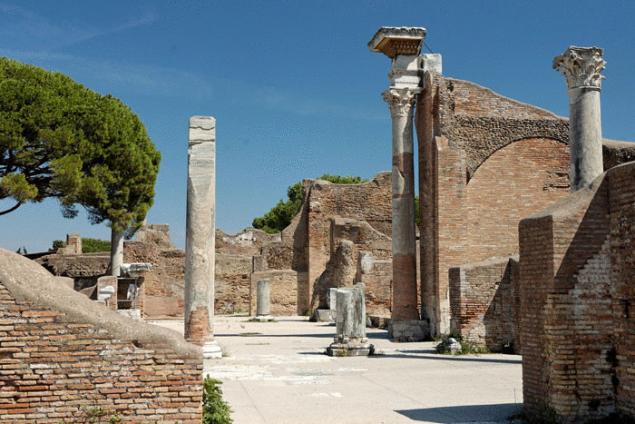
In Ostia-Antica preserved many ancient mosaics. Almost all of them are baths, which are about a dozen. Baths in the forum, the Baths of Neptune, the Sea thermal baths in Roman times they were centers of social life.
Walking around the city, you will find that there are so many different churches, there is even a synagogue and a Christian Basilica! The largest Capitol building – dedicated to the triad of Roman gods: Jupiter, Juno, and Minerva. In Ostia is also very honored Mithras, the Persian God of harmony, and was erected in his honour no less 18 temples.
There in the city and the theater, which was built by Agrippa in the first century BC and could seat 3,000 spectators. At the end of last century it was completely renovated and now again fulfills its direct functions: summer evenings there are shows and performances under the open sky.
Ancient amphitheater in Ostia-Antica
Museum after Spending a few hours walking through the ruins, the rare tourist will find the strength to explore and more Museum. A very good reason!
The Museum houses a rich collection of sculptures, household utensils, objects of glass, bronze and ivory, sarcophagi, funerary paintings and mosaics found during the excavations.
About Ostia is a long story, but it is better to see everything with your own eyes, feel its wonderful ancient atmosphere, and, carrying on the soles of the dust of ages, once again to admire the way the Italians cherish their cultural heritage.
Source: domashniy.ru/
How to get From Rome to Ostia can be easily reached by train. At the metro station Piramide, not leaving the city, follow the signs to Lido to the train station Porta San Paolo. To buy a ticket for the train doesn't need metro ticket is also valid on the suburban trains in this direction. Trains run every 15 minutes, journey time to the station of Ostia Antica – about half an hour.
History According to legend Ostia was founded by the king of Ankh Marcius in the seventh century BC, but scientists this legend is not confirmed – the most ancient building found on the territory of the city, refers to the IV century BC
Ostia was built in a strategically important location at the mouth of the Tiber, and for nearly seven centuries was the "sea gate" of Ancient Rome. The flourishing period of the city coincided with the heyday of the Roman Empire and then gave way to a period of decline. Political chaos in Rome, a series of earthquakes, an epidemic of malaria – and even before the Middle ages from the former greatness of the city is not gone.
Excavations on the site of Ostia began in the nineteenth century and continue to this day. Today, it is 34 hectares, representing 2/3 of the area of the ancient city.
Unlike the infamous Pompeii and Herculaneum, overnight the death toll from the eruption of Vesuvius, Ostia Antica was dying slowly and gradually, allowing us to see a more complete picture of life during the Roman Empire.
The main street Decumanus Maximus
The city On a full inspection of Ostia you will need at least 3-4 hours, so, starting here, choose comfortable shoes and in summer don't forget to bring a hat and sunscreen.
The first thing you will see in Ostia-Antica, is a necropolis situated next to the entrance. Once through, you will come to paved with huge stones at the road – the main street Decumanus Maximus. Navigate here easy, because all major attractions are grouped along this road. You can just move on, leaving alternately to the right and to the left, so checking the map, explore ancient temples, baths and insulin.
But it is possible to turn off the main street, and forgetting about the map, getting lost among the ruins of the ancient city. Deep in weed lanes, dive in a low arch, moving from one dilapidated building to another, accidentally find amazing mosaics and sculptures! To encounter kids playing hide and seek among the ruins, and turning a corner, suddenly to detect the building, which there is absolutely no place for modern cafe with nearby parked cars. Coffee on the terrace overlooking the ancient city and bought some souvenir at the gift shop, to go further.

In Ostia-Antica preserved many ancient mosaics. Almost all of them are baths, which are about a dozen. Baths in the forum, the Baths of Neptune, the Sea thermal baths in Roman times they were centers of social life.
Walking around the city, you will find that there are so many different churches, there is even a synagogue and a Christian Basilica! The largest Capitol building – dedicated to the triad of Roman gods: Jupiter, Juno, and Minerva. In Ostia is also very honored Mithras, the Persian God of harmony, and was erected in his honour no less 18 temples.
There in the city and the theater, which was built by Agrippa in the first century BC and could seat 3,000 spectators. At the end of last century it was completely renovated and now again fulfills its direct functions: summer evenings there are shows and performances under the open sky.
Ancient amphitheater in Ostia-Antica
Museum after Spending a few hours walking through the ruins, the rare tourist will find the strength to explore and more Museum. A very good reason!
The Museum houses a rich collection of sculptures, household utensils, objects of glass, bronze and ivory, sarcophagi, funerary paintings and mosaics found during the excavations.
About Ostia is a long story, but it is better to see everything with your own eyes, feel its wonderful ancient atmosphere, and, carrying on the soles of the dust of ages, once again to admire the way the Italians cherish their cultural heritage.
Source: domashniy.ru/
